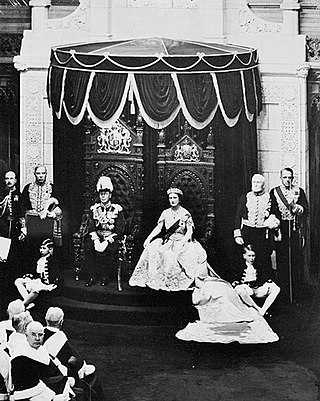Related Research Articles

The Parliament of the United Kingdom of Great Britain and Northern Ireland is the supreme legislative body of the United Kingdom, and may also legislate for the Crown Dependencies and the British Overseas Territories. It meets at the Palace of Westminster in London. Parliament possesses legislative supremacy and thereby holds ultimate power over all other political bodies in the United Kingdom and the Overseas Territories. While Parliament is bicameral, it has three parts: the sovereign (King-in-Parliament), the House of Lords, and the House of Commons. In theory, power is officially vested in the King-in-Parliament. However, the Crown normally acts on the advice of the prime minister, and the powers of the House of Lords are limited to only delaying legislation; thus power is de facto vested in the House of Commons.

The Palace of Westminster is the meeting place of the Parliament of the United Kingdom and is located in London, England. It is commonly called the Houses of Parliament after the House of Commons and the House of Lords, the two legislative chambers which occupy the building. The building was originally constructed in the eleventh century as a royal palace, and Westminster Hall survives from this era.

His Majesty's Most Honourable Privy Council, also known as the Privy Council (PC), officially, is a formal body of advisers to the sovereign of the United Kingdom. Its membership mainly comprises senior politicians who are current or former members of either the House of Commons or the House of Lords.

A postage stamp is a small piece of paper issued by a post office, postal administration, or other authorized vendors to customers who pay postage. Then the stamp is affixed to the face or address-side of any item of mail—an envelope or other postal cover —which they wish to send. The item is then processed by the postal system, where a postmark or cancellation mark—in modern usage indicating date and point of origin of mailing—is applied to the stamp and its left and right sides to prevent its reuse. Next the item is delivered to its addressee.
A first day of issue cover or first day cover (FDC) is a postage stamp on a cover, postal card or stamped envelope franked on the first day the issue is authorized for use within the country or territory of the stamp-issuing authority. Sometimes the issue is made from a temporary or permanent foreign or overseas office. Covers that are postmarked at sea or their next port of call will carry a Paquebot postmark. There will usually be a first day of issue postmark, frequently a pictorial cancellation, indicating the city and date where the item was first issued, and "first day of issue" is often used to refer to this postmark. Depending on the policy of the nation issuing the stamp, official first day postmarks may sometimes be applied to covers weeks or months after the date indicated.

Royal assent is the method by which a monarch formally approves an act of the legislature, either directly or through an official acting on the monarch's behalf. In some jurisdictions, royal assent is equivalent to promulgation, while in others that is a separate step. Under a modern constitutional monarchy, royal assent is considered little more than a formality. Even in nations such as the United Kingdom, Norway, the Netherlands, Liechtenstein and Monaco which still, in theory, permit their monarch to withhold assent to laws, the monarch almost never does so, except in a dire political emergency or on advice of government. While the power to veto by withholding royal assent was once exercised often by European monarchs, such an occurrence has been very rare since the eighteenth century.

Robert Finlayson "Robin" Cook was a British Labour politician who served as a Member of Parliament (MP) from 1974 until his death in 2005 and served in the Cabinet as Foreign Secretary from 1997 until 2001 when he was replaced by Jack Straw. He then served as Leader of the House of Commons from 2001 until 2003.

Edward Henry Garnier, Baron Garnier, is a British barrister and former Conservative Party politician in the United Kingdom. A former lawyer for The Guardian newspaper, Lord Garnier is on the socially liberal wing of his party and was the Member of Parliament (MP) for Harborough in Leicestershire from 1992 until 2017. He most recently served as Solicitor General for England and Wales from the election of 2010 until the 2012 ministerial reshuffle. He stood down from the House of Commons at the 2017 general election before entering the House of Lords in 2018.

John Cradock Maples, Baron Maples was a British politician and life peer who served as Economic Secretary to the Treasury from 1989 to 1992. A member of the Conservative Party, he was Member of Parliament (MP) for Lewisham West from 1983 to 1992 and Stratford-upon-Avon from 1997 to 2010.
In the United Kingdom, representative peers were those peers elected by the members of the Peerage of Scotland and the Peerage of Ireland to sit in the British House of Lords. Until 1999, all members of the Peerage of England held the right to sit in the House of Lords; they did not elect a limited group of representatives. All peers who were created after 1707 as Peers of Great Britain and after 1801 as Peers of the United Kingdom held the same right to sit in the House of Lords.

Postage stamp design is the activity of graphic design as applied to postage stamps. Many thousands of designs have been created since a profile bust of Queen Victoria was adopted for the Penny Black in 1840; some designs have been considered very successful, others less so.

The Supreme Court of the United Kingdom is the final court of appeal in the United Kingdom for all civil cases, and for criminal cases originating in England, Wales and Northern Ireland. As the United Kingdom’s highest appellate court for these matters, it hears cases of the greatest public or constitutional importance affecting the whole population.

The Machin series of postage stamps is the main definitive stamp series in the United Kingdom, used since 5 June 1967. It is the second series to figure the image of Elizabeth II, replacing the Wilding series. The last issue was on 4 April 2022, four months before her death on 8 September.
The Privy Council of England, also known as HisMajesty's Most Honourable Privy Council, was a body of advisers to the sovereign of the Kingdom of England. Its members were often senior members of the House of Lords and the House of Commons, together with leading churchmen, judges, diplomats and military leaders.

Wallace Hamilton Browne, Baron Browne of Belmont, is a Democratic Unionist Party (DUP) politician, who has been a Member of the House of Lords since 2006, and was a Member of the Northern Ireland Assembly (MLA) for East Belfast from 2007 to 2011.
The Sexual Offences Act 1967 is an Act of Parliament in the United Kingdom. It legalised homosexual acts in England and Wales, on the condition that they were consensual, in private and between two men who had attained the age of 21. The law was extended to Scotland by the Criminal Justice (Scotland) Act 1980 and to Northern Ireland by the Homosexual Offences Order 1982.
PAVA spray is an incapacitant spray similar to pepper spray. It is dispensed from a handheld canister, in a liquid stream. It contains a 0.3% solution of pelargonic acid vanillylamide (PAVA), also called nonivamide, a synthetic capsaicinoid, in a solvent of aqueous ethanol. The propellant is nitrogen. This solution has been selected because this is the minimum concentration which will fulfill the purpose of the equipment; namely to minimise a person's capacity for resistance, without unnecessarily prolonging their discomfort.
Dr Jerry Fishenden has been referred to as "one of the UK’s leading authorities in the world of technology", and appears regularly in a variety of mainstream media. He is also a frequent guest and keynote speaker on the conference circuit, drawing on his background across both private and public sectors.

The following is a survey of the postage stamps and postal history of Somalia. From the late 1800s to 1960, northwestern present-day Somalia was administered as British Somaliland, while the northeastern, central and southern part of the country were concurrently administered as Italian Somaliland. In 1960, the two territories were unified as the Somali Republic.

An Act for naturalizing Louis Sechehaye, George Frideric Handel, Anthony Furstenau and Michael Schlegel, later given the short title of Handel's Naturalisation Act 1727, was a 1727 Act of the Parliament of Great Britain with the intent of naturalising German-born composer George Frideric Handel and other foreigners as British subjects.
References
- ↑ "The National Archives". The National Archives. Retrieved 2014-03-12.
- ↑ Department of the Official Report (Hansard), House of Commons, Westminster. "House of Commons Hansard Written Answers for 26 Nov 2008 (pt 0097)". Publications.parliament.uk. Retrieved 2014-03-12.
{{cite web}}: CS1 maint: multiple names: authors list (link) - ↑ "Records created or inherited by the Royal Mail Group plc and predecessors". The National Archives. Retrieved 2014-03-12.
- ↑ Department of the Official Report (Hansard), House of Lords, Westminster (1996-05-23). "Lords Hansard text for 23 May 1996 (160523-02)". Publications.parliament.uk. Retrieved 2014-03-12.
{{cite web}}: CS1 maint: multiple names: authors list (link) - ↑ Helen Nowicka (1996-08-07). "Is Margot Fonteyn a better woman than Vivien Leigh? - News" . The Independent. Archived from the original on 2022-05-24. Retrieved 2014-03-12.
- ↑ Jones, Peter (2004). ""Posting the Future: British Stamp Design and the 'White Heat' of a Technological Revolution"". 17 (2). Journal of Design History: 163–176.
{{cite journal}}: Cite journal requires|journal=(help)